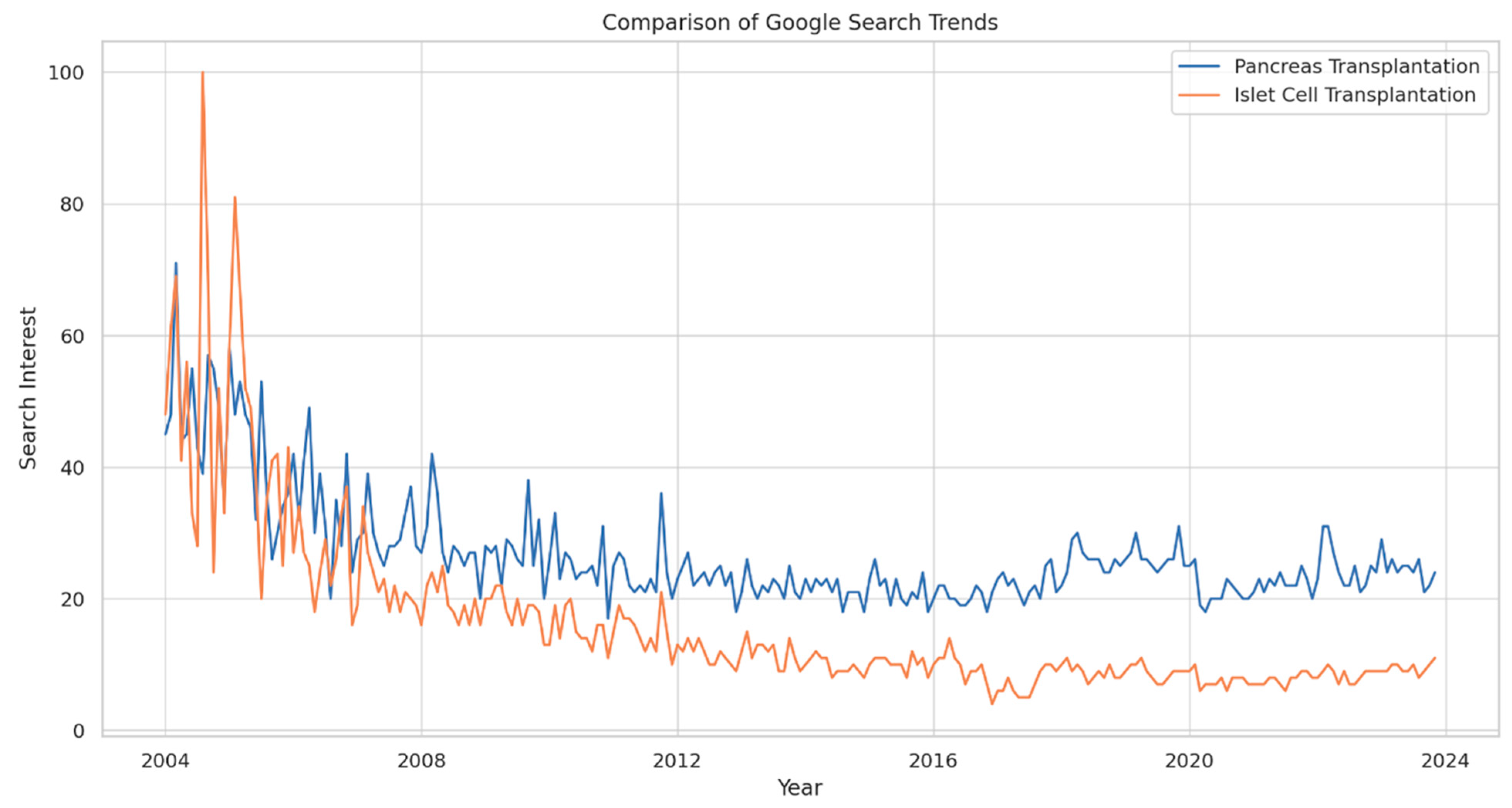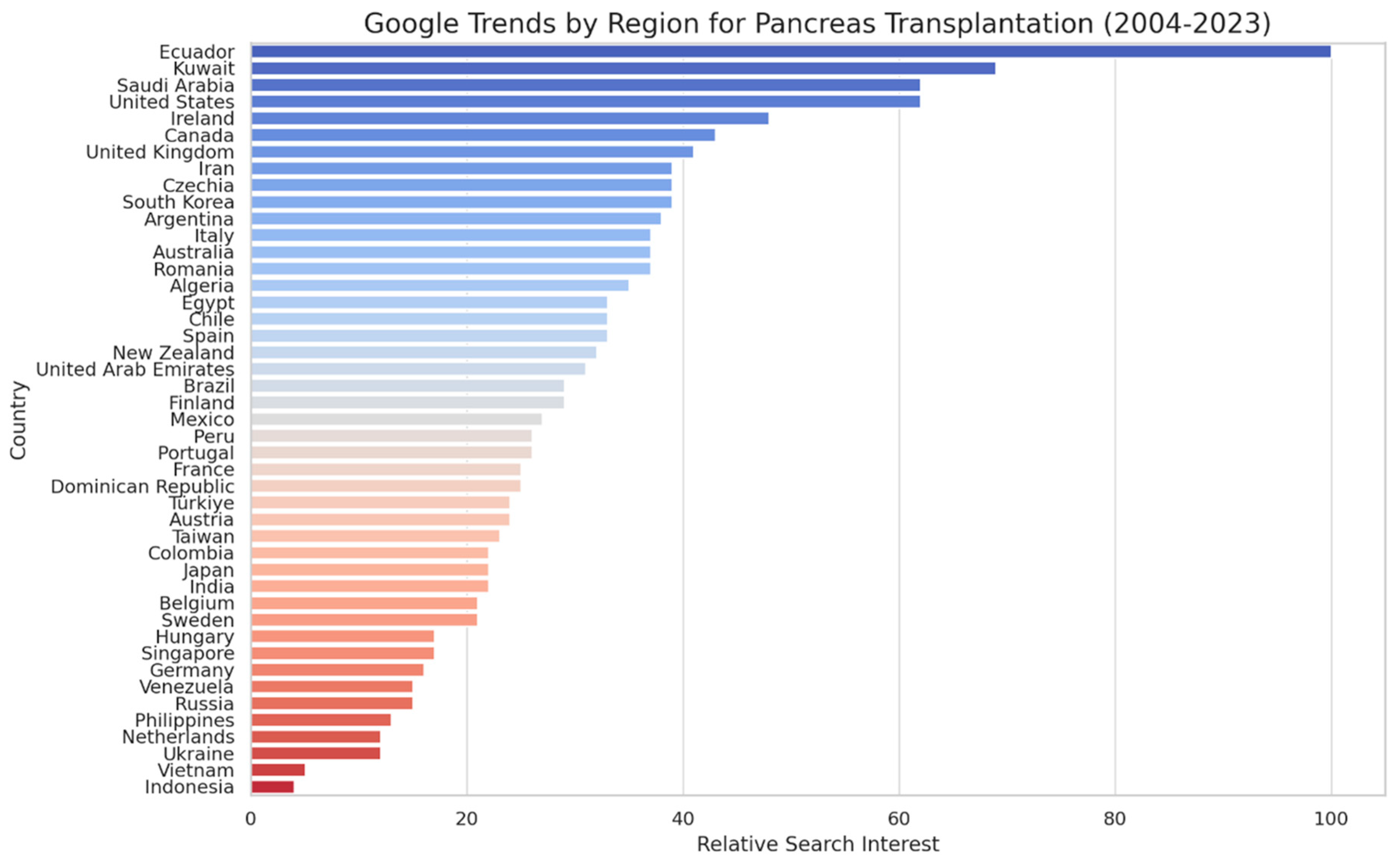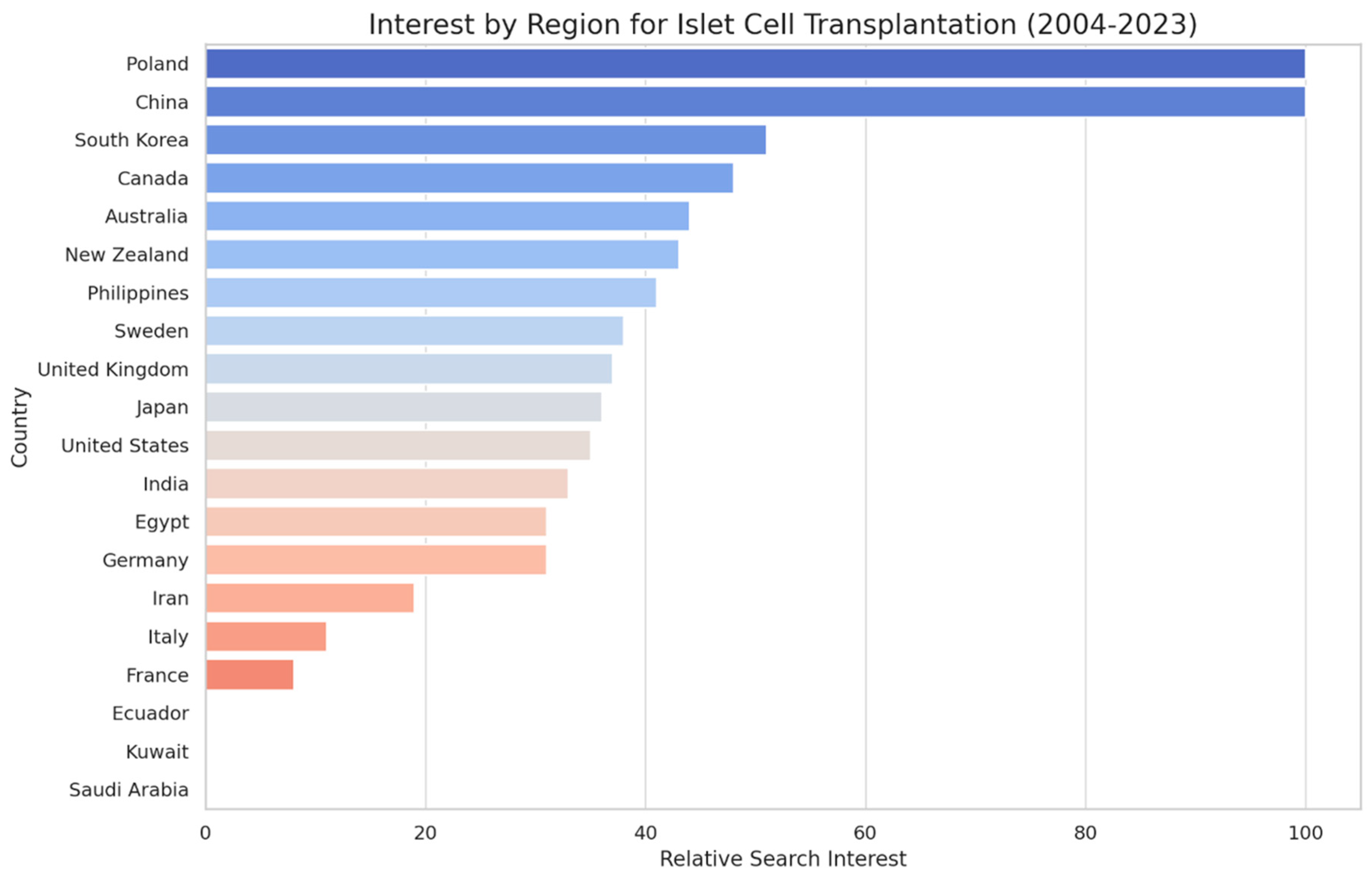Evaluating Global and Temporal Trends in Pancreas and Islet Cell Transplantation: Public Awareness and Engagement
Abstract
1. Introduction
2. Materials and Methods
2.1. Retrieving Google Trends Data on Pancreas and Islet Cell Transplants
2.2. Data Analysis
3. Results
3.1. Comparative Analysis between Transplantation Types
3.2. Stationarity Analysis Using ADF
3.3. Differentiation of Geographic Interest
3.4. Top Related Topics for “Pancreas Transplantation”
3.5. Top Related Topics for “Islet Cell Transplantation”
4. Discussion
5. Conclusions
Author Contributions
Funding
Institutional Review Board Statement
Informed Consent Statement
Data Availability Statement
Conflicts of Interest
References
- Khan, M.A.B.; Hashim, M.J.; King, J.K.; Govender, R.D.; Mustafa, H.; Al Kaabi, J. Epidemiology of Type 2 Diabetes—Global Burden of Disease and Forecasted Trends. J. Epidemiol. Glob. Health 2020, 10, 107–111. [Google Scholar] [CrossRef] [PubMed]
- Susan van, D.; Beulens, J.W.J.; Yvonne T. van der, S.; Grobbee, D.E.; Nealb, B. The global burden of diabetes and its complications: An emerging pandemic. Eur. J. Cardiovasc. Prev. Rehabil. 2010, 17, s3–s8. [Google Scholar] [CrossRef] [PubMed]
- Saeedi, P.; Petersohn, I.; Salpea, P.; Malanda, B.; Karuranga, S.; Unwin, N.; Colagiuri, S.; Guariguata, L.; Motala, A.A.; Ogurtsova, K. Global and regional diabetes prevalence estimates for 2019 and projections for 2030 and 2045: Results from the International Diabetes Federation Diabetes Atlas. Diabetes Res. Clin. Pract. 2019, 157, 107843. [Google Scholar] [CrossRef] [PubMed]
- Sun, H.; Saeedi, P.; Karuranga, S.; Pinkepank, M.; Ogurtsova, K.; Duncan, B.B.; Stein, C.; Basit, A.; Chan, J.C.; Mbanya, J.C. IDF Diabetes Atlas: Global, regional and country-level diabetes prevalence estimates for 2021 and projections for 2045. Diabetes Res. Clin. Pract. 2022, 183, 109119. [Google Scholar] [CrossRef] [PubMed]
- Koye, D.N.; Magliano, D.J.; Reid, C.M.; Jepson, C.; Feldman, H.I.; Herman, W.H.; Shaw, J.E. Risk of Progression of Nonalbuminuric CKD to End-Stage Kidney Disease in People With Diabetes: The CRIC (Chronic Renal Insufficiency Cohort) Study. Am. J. Kidney Dis. 2018, 72, 653–661. [Google Scholar] [CrossRef] [PubMed]
- Ghaderian, S.B.; Hayati, F.; Shayanpour, S.; Beladi Mousavi, S.S. Diabetes and end-stage renal disease; a review article on new concepts. J. Ren. Inj. Prev. 2015, 4, 28–33. [Google Scholar] [CrossRef] [PubMed]
- Matheus, A.S.d.M.; Tannus, L.R.M.; Cobas, R.A.; Palma, C.C.S.; Negrato, C.A.; Gomes, M.d.B. Impact of Diabetes on Cardiovascular Disease: An Update. Int. J. Hypertens. 2013, 2013, 653789. [Google Scholar] [CrossRef] [PubMed]
- Strain, W.D.; Paldánius, P.M. Diabetes, cardiovascular disease and the microcirculation. Cardiovasc. Diabetol. 2018, 17, 57. [Google Scholar] [CrossRef]
- Trautner, C.; Icks, A.; Haastert, B.; Plum, F.; Berger, M. Incidence of blindness in relation to diabetes: A population-based study. Diabetes Care 1997, 20, 1147–1153. [Google Scholar] [CrossRef]
- Romero-Aroca, P. Managing diabetic macular edema: The leading cause of diabetes blindness. World J. Diabetes 2011, 2, 98–104. [Google Scholar] [CrossRef]
- Kropp, M.; Golubnitschaja, O.; Mazurakova, A.; Koklesova, L.; Sargheini, N.; Vo, T.-T.K.S.; de Clerck, E.; Polivka, J.; Potuznik, P.; Polivka, J.; et al. Diabetic retinopathy as the leading cause of blindness and early predictor of cascading complications—Risks and mitigation. EPMA J. 2023, 14, 21–42. [Google Scholar] [CrossRef] [PubMed]
- Fosse, S.; Hartemann-Heurtier, A.; Jacqueminet, S.; Ha Van, G.; Grimaldi, A.; Fagot-Campagna, A. Incidence and characteristics of lower limb amputations in people with diabetes. Diabet. Med. 2009, 26, 391–396. [Google Scholar] [CrossRef] [PubMed]
- Bommer, C.; Sagalova, V.; Heesemann, E.; Manne-Goehler, J.; Atun, R.; Bärnighausen, T.; Davies, J.; Vollmer, S. Global economic burden of diabetes in adults: Projections from 2015 to 2030. Diabetes Care 2018, 41, 963–970. [Google Scholar] [CrossRef] [PubMed]
- Dall, T.M.; Zhang, Y.; Chen, Y.J.; Quick, W.W.; Yang, W.G.; Fogli, J. The economic burden of diabetes. Health Aff. 2010, 29, 297–303. [Google Scholar] [CrossRef] [PubMed]
- Dean, P.G.; Kukla, A.; Stegall, M.D.; Kudva, Y.C. Pancreas transplantation. BMJ 2017, 357, j1321. [Google Scholar] [CrossRef] [PubMed]
- White, S.A.; Shaw, J.A.; Sutherland, D.E.R. Pancreas transplantation. Lancet 2009, 373, 1808–1817. [Google Scholar] [CrossRef]
- Nath, D.S.; Gruessner, A.C.; Kandaswamy, R.; Gruessner, R.W.; Sutherland, D.E.; Humar, A. Outcomes of pancreas transplants for patients with type 2 diabetes mellitus. Clin. Transplant. 2005, 19, 792–797. [Google Scholar] [CrossRef] [PubMed]
- Larsen, J.L. Pancreas transplantation: Indications and consequences. Endocr. Rev. 2004, 25, 919–946. [Google Scholar] [CrossRef] [PubMed]
- Robertson, R.P.; Davis, C.; Larsen, J.; Stratta, R.; Sutherland, D. Pancreas and islet transplantation for patients with diabetes. Diabetes Care 2000, 23, 112–116. [Google Scholar] [CrossRef]
- Boggi, U.; Signori, S.; Vistoli, F.; D’Imporzano, S.; Amorese, G.; Consani, G.; Guarracino, F.; Marchetti, P.; Focosi, D.; Mosca, F. Laparoscopic robot-assisted pancreas transplantation: First world experience. Transplantation 2012, 93, 201–206. [Google Scholar] [CrossRef]
- Wang, Y.; Danielson, K.K.; Ropski, A.; Harvat, T.; Barbaro, B.; Paushter, D.; Qi, M.; Oberholzer, J. Systematic analysis of donor and isolation factor’s impact on human islet yield and size distribution. Cell Transplant. 2013, 22, 2323–2333. [Google Scholar] [CrossRef] [PubMed]
- Kandaswamy, R.; Stock, P.G.; Miller, J.M.; Booker, S.E.; White, J.; Israni, A.K.; Snyder, J.J. OPTN/SRTR 2022 Annual Data Report: Pancreas. Am. J. Transplant. 2024, 24, S119–S175. [Google Scholar] [CrossRef] [PubMed]
- Posselt, A.M.; Bellin, M.D.; Tavakol, M.; Szot, G.L.; Frassetto, L.A.; Masharani, U.; Kerlan, R.K.; Fong, L.; Vincenti, F.G.; Hering, B.J.; et al. Islet transplantation in type 1 diabetics using an immunosuppressive protocol based on the anti-LFA-1 antibody efalizumab. Am. J. Transplant. 2010, 10, 1870–1880. [Google Scholar] [CrossRef] [PubMed]
- Posselt, A.M.; Szot, G.L.; Frassetto, L.A.; Masharani, U.; Tavakol, M.; Amin, R.; McElroy, J.; Ramos, M.D.; Kerlan, R.K.; Fong, L.; et al. Islet transplantation in type 1 diabetic patients using calcineurin inhibitor-free immunosuppressive protocols based on T-cell adhesion or costimulation blockade. Transplantation 2010, 90, 1595–1601. [Google Scholar] [CrossRef] [PubMed]
- Pagliuca, F.W.; Millman, J.R.; Gürtler, M.; Segel, M.; Van Dervort, A.; Ryu, J.H.; Peterson, Q.P.; Greiner, D.; Melton, D.A. Generation of functional human pancreatic β cells in vitro. Cell 2014, 159, 428–439. [Google Scholar] [CrossRef] [PubMed]
- Rezania, A.; Bruin, J.E.; Arora, P.; Rubin, A.; Batushansky, I.; Asadi, A.; O’Dwyer, S.; Quiskamp, N.; Mojibian, M.; Albrecht, T.; et al. Reversal of diabetes with insulin-producing cells derived in vitro from human pluripotent stem cells. Nat. Biotechnol. 2014, 32, 1121–1133. [Google Scholar] [CrossRef] [PubMed]
- Millman, J.R.; Xie, C.; Van Dervort, A.; Gürtler, M.; Pagliuca, F.W.; Melton, D.A. Generation of stem cell-derived β-cells from patients with type 1 diabetes. Nat. Commun. 2016, 7, 11463. [Google Scholar] [CrossRef] [PubMed]
- Yoshihara, E.; O’Connor, C.; Gasser, E.; Wei, Z.; Oh, T.G.; Tseng, T.W.; Wang, D.; Cayabyab, F.; Dai, Y.; Yu, R.T.; et al. Immune-evasive human islet-like organoids ameliorate diabetes. Nature 2020, 586, 606–611. [Google Scholar] [CrossRef] [PubMed]
- Gruessner, R.W.; Gruessner, A.C. The current state of pancreas transplantation. Nat. Rev. Endocrinol. 2013, 9, 555–562. [Google Scholar] [CrossRef]
- Chhabra, P.; Sutherland, D.E.R.; Brayman, K.L. Overcoming barriers in clinical islet transplantation: Current limitations and future prospects. Curr. Probl. Surg. 2014, 51, 49–86. [Google Scholar] [CrossRef]
- Dholakia, S.; Mittal, S.; Quiroga, I.; Gilbert, J.; Sharples, E.J.; Ploeg, R.J.; Friend, P.J. Pancreas transplantation: Past, present, future. Am. J. Med. 2016, 129, 667–673. [Google Scholar] [CrossRef] [PubMed]
- Robertson, R.P.; Davis, C.; Larsen, J.; Stratta, R.; Sutherland, D.E. Pancreas and islet transplantation in type 1 diabetes. Diabetes Care 2006, 29, 935. [Google Scholar] [PubMed]
- Gruessner, R.W.; Sutherland, D.E.; Kandaswamy, R.; Gruessner, A.C. Over 500 solitary pancreas transplants in nonuremic patients with brittle diabetes mellitus. Transplantation 2008, 85, 42–47. [Google Scholar] [CrossRef] [PubMed]
- Kandaswamy, R.; Stock, P.G.; Miller, J.M.; White, J.; Booker, S.E.; Israni, A.K.; Snyder, J.J. OPTN/SRTR 2021 Annual Data Report: Pancreas. Am. J. Transplant. 2023, 23, S121–S177. [Google Scholar] [CrossRef] [PubMed]
- Stratta, R.; Gruessner, A.; Odorico, J.; Fridell, J.; Gruessner, R. Pancreas transplantation: An alarming crisis in confidence. Am. J. Transplant. 2016, 16, 2556–2562. [Google Scholar] [CrossRef] [PubMed]
- Gruessner, A.C.; Gruessner, R.W.G. Declining Numbers of Pancreas Transplantations but Significant Improvements in Outcome. Transplant. Proc. 2014, 46, 1936–1937. [Google Scholar] [CrossRef]
- Google. Google Trends. Available online: https://trends.google.com/trends/ (accessed on 5 January 2024).
- Schuurman, G.S.; Bont, L. Social listening and google trends as tools for estimating public awareness of respiratory syncytial virus. Pediatr. Infect. Dis. J. 2022, 41, e292–e295. [Google Scholar] [CrossRef] [PubMed]
- Arora, V.S.; McKee, M.; Stuckler, D. Google Trends: Opportunities and limitations in health and health policy research. Health Policy 2019, 123, 338–341. [Google Scholar] [CrossRef] [PubMed]
- Mavragani, A.; Ochoa, G. Google Trends in Infodemiology and Infoveillance: Methodology Framework. JMIR Public Health Surveill. 2019, 5, e13439. [Google Scholar] [CrossRef]
- Kronbichler, A.; Effenberger, M.; Shin, J.I.; Koppelstätter, C.; Denicolò, S.; Rudnicki, M.; Neuwirt, H.; Soler, M.J.; Stevens, K.; Bruchfeld, A.; et al. Is There Decreasing Public Interest in Renal Transplantation? A Google Trends(TM) Analysis. J. Clin. Med. 2020, 9, 1048. [Google Scholar] [CrossRef]
- Younis, J.; Freitag, H.; Ruthberg, J.S.; Romanes, J.P.; Nielsen, C.; Mehta, N. Social Media as an Early Proxy for Social Distancing Indicated by the COVID-19 Reproduction Number: Observational Study. JMIR Public Health Surveill. 2020, 6, e21340. [Google Scholar] [CrossRef] [PubMed]
- Nuti, S.V.; Wayda, B.; Ranasinghe, I.; Wang, S.; Dreyer, R.P.; Chen, S.I.; Murugiah, K. The use of google trends in health care research: A systematic review. PLoS ONE 2014, 9, e109583. [Google Scholar] [CrossRef] [PubMed]
- Silva, R.P.; Zarpelão, B.B.; Cano, A.; Junior, S.B. Time Series Segmentation Based on Stationarity Analysis to Improve New Samples Prediction. Sensors 2021, 21, 7333. [Google Scholar] [CrossRef] [PubMed]
- Bode, B.W.; Sabbah, H.T.; Gross, T.M.; Fredrickson, L.P.; Davidson, P.C. Diabetes management in the new millennium using insulin pump therapy. Diabetes/Metab. Res. Rev. 2002, 18, S14–S20. [Google Scholar] [CrossRef] [PubMed]
- Maiorino, M.I.; Signoriello, S.; Maio, A.; Chiodini, P.; Bellastella, G.; Scappaticcio, L.; Longo, M.; Giugliano, D.; Esposito, K. Effects of continuous glucose monitoring on metrics of glycemic control in diabetes: A systematic review with meta-analysis of randomized controlled trials. Diabetes Care 2020, 43, 1146–1156. [Google Scholar] [CrossRef] [PubMed]
- Agulnick, A.D.; Ambruzs, D.M.; Moorman, M.A.; Bhoumik, A.; Cesario, R.M.; Payne, J.K.; Kelly, J.R.; Haakmeester, C.; Srijemac, R.; Wilson, A.Z.; et al. Insulin-Producing Endocrine Cells Differentiated In Vitro From Human Embryonic Stem Cells Function in Macroencapsulation Devices In Vivo. Stem Cells Transl. Med. 2015, 4, 1214–1222. [Google Scholar] [CrossRef]
- Henry, R.R.; Pettus, J.; Wilensky, J.; SHAPIRO, A.J.; Senior, P.A.; Roep, B.; Wang, R.; Kroon, E.J.; Scott, M.; D’AMOUR, K. Initial clinical evaluation of VC-01TM combination product—A stem cell–derived islet replacement for type 1 diabetes (T1D). Diabetes 2018, 67, 138-OR. [Google Scholar] [CrossRef]
- The World Bank. GDP per capita (current US $). In The World Bank Data; The World Bank: Washington, DC, USA, 2021. [Google Scholar]





Disclaimer/Publisher’s Note: The statements, opinions and data contained in all publications are solely those of the individual author(s) and contributor(s) and not of MDPI and/or the editor(s). MDPI and/or the editor(s) disclaim responsibility for any injury to people or property resulting from any ideas, methods, instructions or products referred to in the content. |
© 2024 by the authors. Licensee MDPI, Basel, Switzerland. This article is an open access article distributed under the terms and conditions of the Creative Commons Attribution (CC BY) license (https://creativecommons.org/licenses/by/4.0/).
Share and Cite
Garcia Valencia, O.A.; Thongprayoon, C.; Jadlowiec, C.C.; Mao, S.A.; Leeaphorn, N.; Budhiraja, P.; Khoury, N.; Vaitla, P.; Suppadungsuk, S.; Cheungpasitporn, W. Evaluating Global and Temporal Trends in Pancreas and Islet Cell Transplantation: Public Awareness and Engagement. Clin. Pract. 2024, 14, 590-601. https://doi.org/10.3390/clinpract14020046
Garcia Valencia OA, Thongprayoon C, Jadlowiec CC, Mao SA, Leeaphorn N, Budhiraja P, Khoury N, Vaitla P, Suppadungsuk S, Cheungpasitporn W. Evaluating Global and Temporal Trends in Pancreas and Islet Cell Transplantation: Public Awareness and Engagement. Clinics and Practice. 2024; 14(2):590-601. https://doi.org/10.3390/clinpract14020046
Chicago/Turabian StyleGarcia Valencia, Oscar A., Charat Thongprayoon, Caroline C. Jadlowiec, Shennen A. Mao, Napat Leeaphorn, Pooja Budhiraja, Nadeen Khoury, Pradeep Vaitla, Supawadee Suppadungsuk, and Wisit Cheungpasitporn. 2024. "Evaluating Global and Temporal Trends in Pancreas and Islet Cell Transplantation: Public Awareness and Engagement" Clinics and Practice 14, no. 2: 590-601. https://doi.org/10.3390/clinpract14020046
APA StyleGarcia Valencia, O. A., Thongprayoon, C., Jadlowiec, C. C., Mao, S. A., Leeaphorn, N., Budhiraja, P., Khoury, N., Vaitla, P., Suppadungsuk, S., & Cheungpasitporn, W. (2024). Evaluating Global and Temporal Trends in Pancreas and Islet Cell Transplantation: Public Awareness and Engagement. Clinics and Practice, 14(2), 590-601. https://doi.org/10.3390/clinpract14020046






